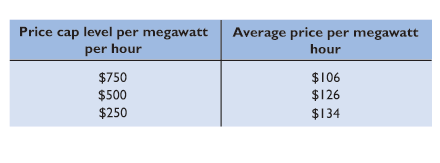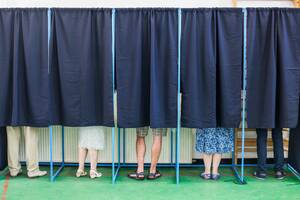History has not been kind to price controls. During the French Revolution, caps on food prices that were lower than the cost of production encouraged merchants to keep their wares for themselves or sell them on the black market. During America’s first energy crisis in the 1970s, a policy meant to encourage oil exploration set higher prices for new oil than for crude from already-discovered wells, leading to the withdrawal of “old oil” from the market. Recently, price caps meant to address hyperinflation in Zimbabwe have resulted in scarcity: demand surged, inventory plummeted, and Zimbabwe’s manufacturers could no longer afford to buy the raw materials to produce more goods.
Among some policy makers and economists, however, price caps still enjoy a reputation for protecting consumers from artificially high prices in a market dominated by one or just a few sellers. In the United States price ceilings have been employed in a number of industries, including telecommunications (remember Ma Bell?), insurance, and the apartment rental markets of New York, San Francisco, Washington, D.C., and other major cities.
A price cap—particularly a high one—tends to cause sellers to decrease production, trying to drive up demand and therefore prices close to that price ceiling.Among proponents, “everyone believes that price caps work when we know how much demand for a good is out there,” says the Kellogg School’s Karl Schmedders (Managerial Economics and Decision Sciences). If a product’s price is limited, the seller’s motivation to limit supply and thereby drive price increases is removed, so supplies are plentiful and prices are low. But Schmedders and a friend from graduate school, energy expert Robert Earle, saw just the opposite in another example of price controls: the California electricity markets a decade ago. Although the markets opened without regulation for the first time in 1998, wildly fluctuating prices convinced regulators to impose price controls on some parts of the market. But instead of moderating electricity prices, the price caps seemed to be associated with raising them. As the caps were lowered throughout 2000, the average price for electricity increased.

The difference between other markets and California’s electricity market, it seemed to Schmedders and Earle, was that the sellers could not accurately determine in advance the demand for the electricity they were producing. Demand is subject to the whims of weather, among other things, and electricity—unlike most goods—cannot be easily shelved for sale later. “Now we had to wonder about this traditional theory: How does it work in the face of uncertain demand?” Schmedders asks. Schmedders, Earle, and Tymon Tatur, then a Kellogg School graduate student and research assistant, set to work on a new mathematical model of price caps. Their work appeared in the Review of Economic Studies.
Price Caps and Uncertain Demand
For all the faith that some economists and policy makers have in old-fashioned price caps when demand is known, Schmedders and his colleagues couldn’t find any relevant mathematical models in the research literature. Their first task, then, was to develop a model that described this condition. Just as they and economic theory anticipated, the model showed that a price cap—particularly a high one—tends to cause a seller to decrease production, trying to drive demand and therefore prices close to that price ceiling. But if the price cap is lowered toward the seller’s marginal cost, which is the production cost of the last unit of any hypothetical good, the market reaches an “efficient level.” Schmedders explains, “Usually you only get this efficient level with infinitely many producers—perfect competition—and because competition is so intense, you get the best possible scenario.” At that efficient level, consumers enjoy low prices and adequate supply while sellers make enough profit to continue to produce goods.
When the team worked through their model, inspired by the conditions of uncertain demand they saw in California’s electricity market in 2000, the outcomes predicted by traditional price cap theory were reversed. According to the model, when demand was uncertain and price caps got closer to the marginal cost of a good, sellers chose to decrease production or withhold their products from market.
“The producer gets punished when there’s high demand and prices would have been high, but now the producer can’t charge a really high price because there’s a price cap. The ‘good’ uncertainty for the producer gets cut off, but the ‘bad’ uncertainty is still there, so the producers reduce their production,” Schmedders says. Consumers do not get the goods they want, but sellers also do not get to benefit from high demand. “On average,” Schmedders continues, “there’s lower production and higher prices, which is exactly the opposite of what the policy makers intended.”
Applying Results to Varied Uncertainty
These outcomes held even when the model was adjusted to reflect different kinds of uncertainty in demand. “The uncertainty may be that the demand for a good is between 100 and 200 units and every number is equally likely,” says Schmedders. “Or it could be the 150 to 160 units in the middle are much more likely to be in demand than those on the sides, like a bell curve.” No matter the particular kind of uncertainty, “these results apply if you have some uncertainty.”
Finally, the team constructed an economic world in which the “product”—unlike electricity—did not have an expiration date and could be sold later once demand had stabilized. Again the model showed that production did not increase, prices did not decrease, and neither the consumer nor the producer realized benefits.
These many schemes demonstrate that the team’s model is applicable to a variety of potential—and potentially messy—conditions that might occur in any market in which demand cannot be determined with confidence.
With America’s economy battered by one bursting bubble after another and a new leader at the helm, “we may enter an era where people say more regulation is better,” Schmedders says. But he counsels that one really has to weigh both the long-term and short-term downside of price caps against what they might achieve in the short run. According to Schmedders, “In the face of demand uncertainty, a lot of conventional economic wisdom may get overturned.”
Earle, Robert, Karl Schmedders, Tymon Tatur (2007). “On Price Caps Under Uncertainty,” Review of Economic Studies, 74(1): 93-111.


